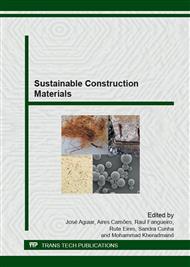p.339
p.351
p.357
p.367
p.379
p.389
p.400
p.410
p.421
Buckling of Masts of Bamboos Bundles
Abstract:
Bamboos generally have elasticity module in compression of about 9 GPa, which is a relatively low value compared to timber and concrete, 20 GPa, and steel, 200 GPa. However, the compressive strength is high - 40 to 80 MPa – that, combined with axissimetria of the cross section, makes the bamboos structural elements with high strength and flexibility. Considering the low apparent specific weight of the material 8 kN/m3, photosynthetic production and workability, bamboos have no competitor in the market so that loads can be absorbed independently by any of the above materials. But the industrial structural elements may be produced with dimensions and geometries provided in accordance with the load to be transported. This is not the case of bamboo. Thus, the capacity of the bamboo in compression becomes limited by its natural flexural rigidity, EI. Thus, different structural systems with pipe threads to make large columns or masts were investigated, [1,2], all with bamboo Phyllostachys pubescens species. In this paper, a kind of mast composed of a central bamboo 6 m in length and six smaller segments axi-symmetrically distributed around this central bamboo will be presented. This proposed design is organizationally a set of bars shackled by steel bands along the length of the beam. Flexion-compression tests with bamboo species Phyllostachys pubescens, combined with numerical modeling through the MEF were made. The loading capacity was tripled and the lateral deviations are negligible when compared with the axial bamboo tested alone. This mast, while consuming a relatively high number of bamboo units, has the advantages of ease and constructive possibility of structural use of smaller diameter bamboo. All the design and results of experimental and numerical analyzes will be discussed in this paper.
Info:
Periodical:
Pages:
379-388
Citation:
Online since:
December 2014
Keywords:
Price:
Сopyright:
© 2015 Trans Tech Publications Ltd. All Rights Reserved
Share:
Citation:


